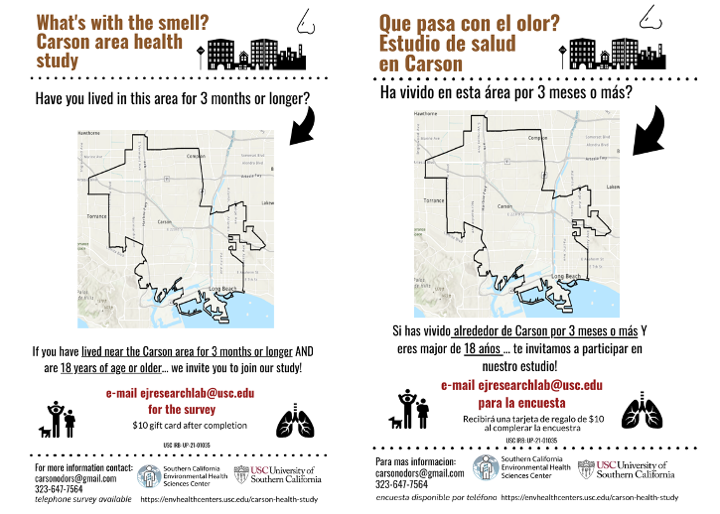Health, Odors, & Air Quality Survey
In response to health concerns of residents in and around Carson, CA in Fall of 2021, we launched a health survey to assess short and longer-term impacts of the odors and hydrogen sulfide concentrations. The survey can be completed online in 20-30 minutes and participants will receive a $10 gift card for their time. Adult residents (18 years or older) of the Carson area may email ejresearchlab@usc.edu or call 323-647-7564 for more information. Summary findings will be shared with participants and the community. Below we share resources and epidemiological studies on the health effects associated with exposure to hydrogen sulfide.

Si has vivido alrededor de Carson por 6 meses o más Y eres major de 18 ańos, te invitamos a participar en nuestro estudio!
E-mail ejresearchlab@usc.edu para la encuesta
Recibirá una tarjeta de regalo de $10 al complerar la encuestra
Para mas informacion: carsonodors@gmail.com, 323-647-7564
USC IRB: UP-21-01035
Avery, R. C., Wing, S., Marshall, S. W., & Schiffman, S. S. (2004). Odor from industrial hog farming operations and mucosal immune function in neighbors. Arch Environ Health, 59(2), 101-108. https://doi.org/10.3200/aeoh.59.2.101-108
Beauchamp, R. O., Jr., Bus, J. S., Popp, J. A., Boreiko, C. J., & Andjelkovich, D. A. (1984). A critical review of the literature on hydrogen sulfide toxicity. Crit Rev Toxicol, 13(1), 25-97. https://doi.org/10.3109/10408448409029321
Horton, R. A., Wing, S., Marshall, S. W., & Brownley, K. A. (2009). Malodor as a trigger of stress and negative mood in neighbors of industrial hog operations. Am J Public Health, 99 Suppl 3(Suppl 3), S610-615. https://doi.org/10.2105/ajph.2008.148924
Jaakkola, J. J., Vilkka, V., Marttila, O., Jäppinen, P., & Haahtela, T. (1990). The South Karelia Air Pollution Study. The effects of malodorous sulfur compounds from pulp mills on respiratory and other symptoms. Am Rev Respir Dis, 142(6 Pt 1), 1344-1350. https://doi.org/10.1164/ajrccm/142.6_Pt_1.1344
Jäppinen, P., Vilkka, V., Marttila, O., & Haahtela, T. (1990). Exposure to hydrogen sulphide and respiratory function. Br J Ind Med, 47(12), 824-828. https://doi.org/10.1136/oem.47.12.824
Legator, M. S., Singleton, C. R., Morris, D. L., & Philips, D. L. (2001). Health effects from chronic low-level exposure to hydrogen sulfide. Arch Environ Health, 56(2), 123-131. https://doi.org/10.1080/00039890109604063
Radon, K., Schulze, A., Ehrenstein, V., van Strien, R. T., Praml, G., & Nowak, D. (2007). Environmental exposure to confined animal feeding operations and respiratory health of neighboring residents. Epidemiology, 18(3), 300-308. https://doi.org/10.1097/01.ede.0000259966.62137.84
Schiffman, S. S., Studwell, C. E., Landerman, L. R., Berman, K., & Sundy, J. S. (2005). Symptomatic effects of exposure to diluted air sampled from a swine confinement atmosphere on healthy human subjects. Environ Health Perspect, 113(5), 567-576. https://doi.org/10.1289/ehp.6814
Schinasi, L., Horton, R. A., Guidry, V. T., Wing, S., Marshall, S. W., & Morland, K. B. (2011). Air pollution, lung function, and physical symptoms in communities near concentrated Swine feeding operations. Epidemiology, 22(2), 208-215. https://doi.org/10.1097/EDE.0b013e3182093c8b
Shusterman, D. (2001). Odor-associated health complaints: competing explanatory models. Chem Senses, 26(3), 339-343. https://doi.org/10.1093/chemse/26.3.339
Tajik, M., Muhammad, N., Lowman, A., Thu, K., Wing, S., & Grant, G. (2008). Impact of odor from industrial hog operations on daily living activities. New Solut, 18(2), 193-205. https://doi.org/10.2190/NS.18.2.i
Wing, S., Horton, R. A., & Rose, K. M. (2013). Air pollution from industrial swine operations and blood pressure of neighboring residents. Environ Health Perspect, 121(1), 92-96. https://doi.org/10.1289/ehp.1205109



